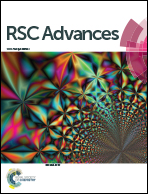Vitamin E TPGS based nanogel for the skin targeting of high molecular weight anti-fungal drug: development and in vitro and in vivo assessment
Abstract
The molecules having a molecular weight greater than 500 Da are considered to be ineffective in the treatment of skin diseases due to their low skin permeation. The present study entails the development of a Vitamin E TPGS nanoemulsion based nanogel formulation for the high molecular weight drug, amphotericin B (AmB 923 Da), intended for the effective treatment of cutaneous fungal infections. The nanoemulsion formulations were prepared in strengths similar to the marketed topical formulation and optimized with respect to the Smix ratio (surfactant : co-surfactant), type of surfactant, co-surfactant, globule size, size distribution, percent transmittance, dispersibility, viscosity and rheology. The optimized nanoemulsion formulation was further incorporated into a gel base to form the AmB nanogel formulation. When compared to the marketed topical formulation, the optimized nanogel exhibited a 3.9 fold higher skin deposition through porcine ear skin. Confocal laser scanning microscopy studies (CLSM) showed the specific distribution of AmB in different parts of the skin and confirmed the permeation of the nanogel to the deeper layers of the skin. The antifungal activity of the optimized nanogel formulation was tested using microdilution method and found to be 2.0 fold higher against Aspergillus niger and Candida albicans in contrast to the marketed formulation. The results show that the prepared nanogel formulation is a better alternative for effective topical delivery of AmB.


 Please wait while we load your content...
Please wait while we load your content...